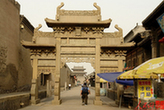Brief Introduction
This is an unusual ecosystem, with narrow conic karst landforms, renowned for its rolling mountains, dense forests, colorful lakes, precipitous waterfalls, and a wide variety of birds and animals.
Stretching over 600 sq km in the northern part of Sichuan Province, the jagged peaks around Jiuzhaigou Valley reach heights of more than 4,800 m. In the valley there is a series of diverse forest ecosystems. Its superb landscapes are especially interesting for their narrow conic karst landforms and spectacular waterfalls. Some 140 bird species inhabit the valley, as well as a number of endangered plant and animal species, including the giant panda and the Sichuan takin.
Physical Features
Lying on the edge of the diverging belt between the Qinghai-Tibet Plate and the Yangtze Plate, there are major faultlines running through the site. Earthquakes are not uncommon and have been a major influence on the geological landscape. Of the greatest interest, geologically, are the high altitude karst land forms which have been strongly influenced by glacial, hydrological and tectonic activity.
The main valley is 50 km long, and is where Shuzheng, Qunhai, Rize, and Zechawa valleys come together. Waterfalls and streams link 108 lakes of various sizes, many of which are classic ribbon lakes at the base of glacially formed valleys.
Also of note are a number of large and spectacular waterfalls, including Xionguashai (Panda Lake) Fall which drops 78m in three steps, and the Zhengzhutan (Pearl Shoal) Fall, which drops 28m in a broad curtain of water, 310m wide.
According to geologists, the lakes were formed by calcium carbonate in the flowing water when the earth was in the interglacial stage. The calcium carbonate could not coagulate, but flowed with the water. More than 12,000 years ago, the global climate became warmer, and the calcium carbonate became active and attached itself to obstacles in the water. As time passed, the attached matter became thicker, forming the milky white banks of barrier lakes.
The view of Five-Flower Lake in Rize Valley is majestic. Looking down from the mountain, one can see the lake hemmed in on three sides by mountains. The lake looks like a big gourd pouring colorful water endlessly. At the bottom of the lake, there are small, dark-green plum-shaped spots, and in the middle of the gourd is a light-blue figure 10 m long, shaped like the leg of a sika deer. It is said that when the Mountain God appeared on the mountain, a frightened sika seer lost a leg, which dropped into the lake.





Why not rent a boyfriend, or girlfriend to please parents during the Spring Festival?